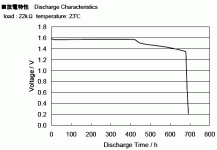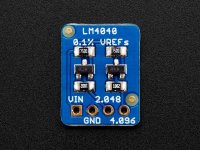I have 3 DMM and they all measure a little different.
One alot of different,how do I fint out wich one is most accurate?
One alot of different,how do I fint out wich one is most accurate?
First check the batteries are not simply dying in the poor one.
Do you have any precision resistors (0.1% or better)? Any kind of voltage reference?
Do you have any precision resistors (0.1% or better)? Any kind of voltage reference?
Will change the battery in The poor one.
And order a precission resitor The next time I order.
Voltade referenser,what could that be.
And order a precission resitor The next time I order.
Voltade referenser,what could that be.
Just quoting from memory, a *Silver* battery, a true one, not an Alkaline "equivalent" used to be a stable Lab reference, at least to calibrate a VTVM in the old days.
Stable 1.55V on an unused one and you can get yours almost anywhere,even Wal Mart or equivalent.
Must be read with a high impedance meter (1M or 10M) for maximum precision.
"Just because I can" 😉 I calibrate my yellow $10 meters with one of them, there is a small trimmer inside for that purpose.
I guess factory does a similar thing, it takes all of 15 seconds 🙂
If you want a serious reference, many good ideas here:
Build A .01% Accurate Voltage Reference | Nuts & Volts Magazine
EDIT:the main article suggestion reference IC is obsolete, although "one" might still be found, not in manufacturing quantities of course.
If not, it gives you ideas to search for modern equivalents.
But I still guess the cheap easy to find silver battery reference will be close enough for common Tech use.
Stable 1.55V on an unused one and you can get yours almost anywhere,even Wal Mart or equivalent.
Must be read with a high impedance meter (1M or 10M) for maximum precision.
"Just because I can" 😉 I calibrate my yellow $10 meters with one of them, there is a small trimmer inside for that purpose.
I guess factory does a similar thing, it takes all of 15 seconds 🙂
If you want a serious reference, many good ideas here:
Build A .01% Accurate Voltage Reference | Nuts & Volts Magazine
EDIT:the main article suggestion reference IC is obsolete, although "one" might still be found, not in manufacturing quantities of course.
If not, it gives you ideas to search for modern equivalents.
But I still guess the cheap easy to find silver battery reference will be close enough for common Tech use.
Last edited:
Just quoting from memory, a *Silver* battery, a true one,...
Silver-oxide battery - Wikipedia
Silver Oxide Batteries Standard | Micro Batteries | Murata Manufacturing Co., Ltd.
SR41 is readily available:
https://www.murata.com/products/productdata/8802945663006/SR41-392-384-DATASHEET.pdf?1615298418000
Looks like you should load with 22k for a day to use-up the surface charge. Then replace before 400 hours, which is months in factory calibration and forever in lab use (but the idle cell may self-rot).
Attachments
Attachments
Last edited:
IIRC, a good, unused alkaline cell has an emf of 1.59V or thereabout, with a practically zero tempco.
Certainly not a true reference cell, but a good first step: buy some new cells from various brands and test them.
I can find the exact voltage of a cell somewhere, this will give you more than 3 significant digits and will let you make a first sorting.
In general, if one of the multimeters is widely different from the other ones, it will be the culprit, but it would be nice to have some kind of confirmation
Certainly not a true reference cell, but a good first step: buy some new cells from various brands and test them.
I can find the exact voltage of a cell somewhere, this will give you more than 3 significant digits and will let you make a first sorting.
In general, if one of the multimeters is widely different from the other ones, it will be the culprit, but it would be nice to have some kind of confirmation
I think a Lithium cell (CR series) has a flatter time/voltage curve, and they cost almost the same...they are having nearly the same voltage almost their entire life.
2.96 V, IIRC...
2.96 V, IIRC...
Could this be sommething?
AD854
AD584 4-Channel 2.5V 7.5V 5V 10V High Precision Voltage Reference Module | eBay
AD854
AD584 4-Channel 2.5V 7.5V 5V 10V High Precision Voltage Reference Module | eBay
Hi Ake,
I have built a bunch of "calibrating" toys to play with.
I use a chinese lab power supply (up tp 60V, 5A) to supply any voltage and current I want.
Now for the most important: A Keithley 2015, calibrated in 2016 and not much used since then. This one I call "my reference". This is then used as my display for all the voltages, currents and resistances I want to calibrate some multimeters with.
I built some "stable voltage supplies", consisting of a 10V ref chip in series with 3 3V ref chips. So here I get 10V and 19V.
And one with an ebay 350V step up converter feeding 19 10V references in series. From here I get 100V and 190V.
The one with 990V is still not built.
And I have bought an old and ugly Time electronics DC current calibrator, Type 609 as stable current source.
With this equipment I "calibrated" some Keithley 195 and 197 (to show the same values as my 2015, to be exact).
I only calibrate DC, not AC.
So this is my other hobby, not only audio,
If you like some voltage references, please ask and I will see, if I can build this for you, note the voltage my 2015 shows and send it to you.
You will need then a lab power supply, maybe up to 30V.
Best regards,
Ulf
I have built a bunch of "calibrating" toys to play with.
I use a chinese lab power supply (up tp 60V, 5A) to supply any voltage and current I want.
Now for the most important: A Keithley 2015, calibrated in 2016 and not much used since then. This one I call "my reference". This is then used as my display for all the voltages, currents and resistances I want to calibrate some multimeters with.
I built some "stable voltage supplies", consisting of a 10V ref chip in series with 3 3V ref chips. So here I get 10V and 19V.
And one with an ebay 350V step up converter feeding 19 10V references in series. From here I get 100V and 190V.
The one with 990V is still not built.
And I have bought an old and ugly Time electronics DC current calibrator, Type 609 as stable current source.
With this equipment I "calibrated" some Keithley 195 and 197 (to show the same values as my 2015, to be exact).
I only calibrate DC, not AC.
So this is my other hobby, not only audio,
If you like some voltage references, please ask and I will see, if I can build this for you, note the voltage my 2015 shows and send it to you.
You will need then a lab power supply, maybe up to 30V.
Best regards,
Ulf
0.1% or 0.05% IC voltage reference (plus several 0.1-0.01% resistors) is usually enough to align several usual DMMs together.
There is always the DMMCheck Plus if you don't want to build yourself and scared of the cheap ebay "calibrated" references.
DMMCheck Plus Multimeter Calibration Reference, 189.00 €
I do have a couple of cheap ebay references that I have measured with the meters that I have and can always cross-check again to see if some of the meters drift.
DMMCheck Plus Multimeter Calibration Reference, 189.00 €
I do have a couple of cheap ebay references that I have measured with the meters that I have and can always cross-check again to see if some of the meters drift.
You cannot be sure if the meter or the reference is drifting. One option is a really stable voltage reference like the eBay LM399's. The good part is very high stability. The bad part is the calibrations attached are borderline gibberish. I got one and after confirming the numbers are wrong I modified it and repurposed it as a reference in a precision voltage reference box.
Real accuracy pass 3 1/2 digits turns out to be quite a technical challenge.
Real accuracy pass 3 1/2 digits turns out to be quite a technical challenge.
Fluke Voltage Calibrators have Reference Amps ( they are called) which show very good stability - they have heated chambers to keep the Zener Reference in stable temperatures. you can visit eevblog forum on metrology for information to build one. However you need a voltage standard or calibrated 7-1/2 digit (min 6-1/2 digit calibrated) DMM to set it accurately - and again check its drift. so in reality you need to access a reference DMM with a valid calibration as a starting point
You cannot be sure if the meter or the reference is drifting.
This is not real metrology we are talking about. But when comparing _multiple_ meters against reference (or even multiple references), if all meters show different values next year, you can draw the following conclusion. Either all of your meters are crap or your reference is crap. 😀
Ake,
I have this one, not exactly cheap (beware of shipping and customs fees) but way cheaper than high end stuff and I like it:
https://dmmcheckplus.com/?gclid=EAIaIQobChMI2caCmY648gIVxOF3Ch37Tgh7EAAYASAAEgLU3_D_BwE
It will give you a good idea about how a DMM or even other instruments work (if you include capacitor and inductance options).
It comes calibrated, and they provide a reasonably priced calibration service.
Giuseppe Marullo
IW2JWW - JN45RQ
I have this one, not exactly cheap (beware of shipping and customs fees) but way cheaper than high end stuff and I like it:
https://dmmcheckplus.com/?gclid=EAIaIQobChMI2caCmY648gIVxOF3Ch37Tgh7EAAYASAAEgLU3_D_BwE
It will give you a good idea about how a DMM or even other instruments work (if you include capacitor and inductance options).
It comes calibrated, and they provide a reasonably priced calibration service.
Giuseppe Marullo
IW2JWW - JN45RQ
- Home
- Design & Build
- Equipment & Tools
- Calibrate DMM

